Senator Reverend Warnock speaks to NPR in Warm Springs on the legacy of FDR and our nation’s unfinished work
Published 11:20 pm Sunday, April 20, 2025

- Senator Reverend Warnock with FDR’s infamous unfinished portrait in Warm Springs
Matt Krack press secretary
On Saturday, April 12, on the 80th anniversary of the passing of President Franklin D. Roosevelt, U.S. Senator Reverend Raphael Warnock (D-GA) journeyed to the late president’s Little White House in Warm Springs, Georgia to deliver a keynote address honoring the unfinished legacy of FDR and the unfinished work of creating opportunities for all Americans to thrive regardless of their race, age, creed, or station in life. Ahead of his remarks, Senator Warnock saw FDR’s infamous “unfinished portrait”, a watercolor painting the 32nd president was posing for when he suffered a stroke, which he eventually succumbed to on April 12, 1945. In his remarks, Senator Warnock evoked the unfinished portrait and how it resembles the unfinished legacy and mission of FDR in creating economic, social, and political opportunity for all Americans.
“FDR collapsed from a stroke, never got up, and the portrait was never finished. In a real sense, that’s how we live our lives, even at our best, it is an unfinished project, an unfinished portrait. What remained was a loose watercolor sketch of his head and shoulders. It was an unfinished portrait, an unfinished presidential term, an unfinished legacy, and in many ways, the America he fought for remains unfinished. That brush may have stopped mid stroke, but what Roosevelt painted into the fabric of this nation still colors our lives today,” said Senator Reverend Warnock.
“What [FDR] accomplished was extraordinary, and much of it was inspired by the spirit of Georgia, warmed up by these Warm Springs in which he drew inspiration and motivation that he needed to rebuild an anguished nation. Over the years, after making his first journey here in 1924, President Roosevelt saw the South’s struggling economy, he saw the many challenges of our state. He saw the lack of educational opportunities. He saw the lack of electricity and family farms being foreclosed. He saw poverty and disease, both in a literal sense and in a spiritual sense. And he saw the impact of that in Georgia and on our nation. He saw a lack of good paying jobs, creating a crisis for the economy and, more importantly, a crisis in the human soul. So, as FDR came down to Warm Springs for his own healing. He saw the healing that needed to be done. You can’t lead the people unless you love the people. And in order to love the people, you got to walk with the people,” said Senator Reverend Warnock in his keynote speech.
“So the mission continues, the work still lies ahead. We must not give in to those who are trying to weaponize fear. FDR said, ‘We have nothing to fear but fear itself.’ Now, like all of you, I grew up hearing that, and I must admit that since I’ve been hearing it all my life, it was just, you know, something people say. ‘We have nothing to fear but fear itself.’ It’s one of those things that’s so deep in the culture you hear it without really hearing. I’m not so sure I knew what Roosevelt meant until late, because in this moment in our lives, there are those in high office who are trying to weaponize fear. There are those in high office who want us to be afraid of one another. Want white people to be afraid of Black people, and Black people to be afraid of brown people, want the young to resent the old and the old to forget about the young. We have nothing to fear but fear itself. Translation, if there’s anybody to be afraid of, we ought to be afraid of the politicians who want us to be afraid of one another. We have nothing to fear but fear itself,” Senator Reverend Warnock continued.
Following his remarks, Senator Warnock toured the Little White House where FDR was posing for the unfinished portrait. The senator surveyed the bedroom where the late president eventually succumbed to his stroke, leaving behind a nation in recovery from the Great Depression and on a path to victory in World War II. Senator Warnock also viewed the nearby pools where FDR found some relief in his battle with polio.






